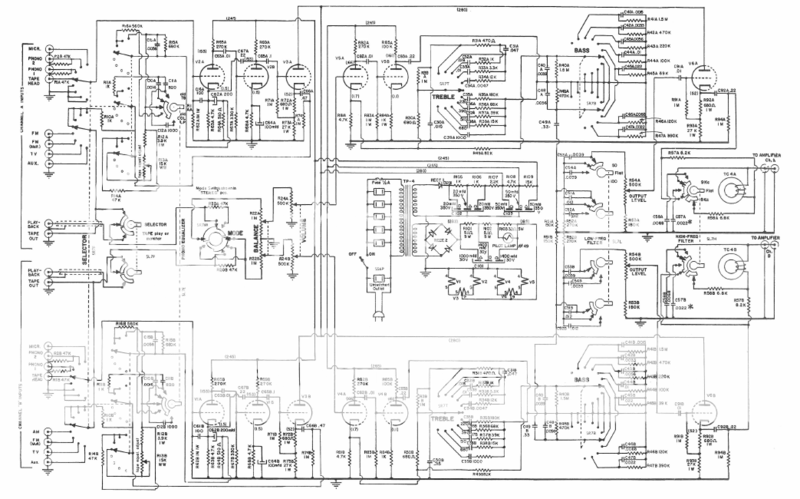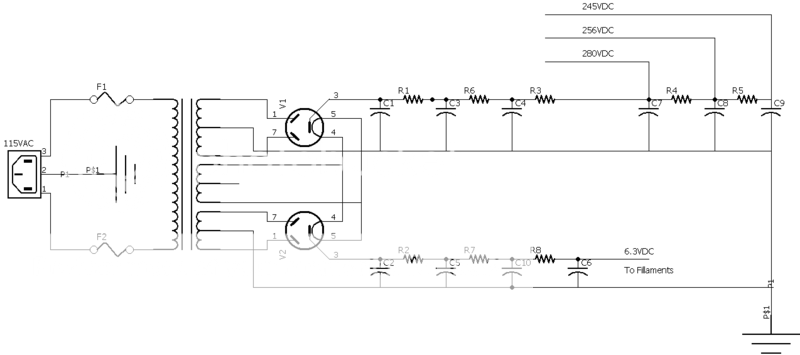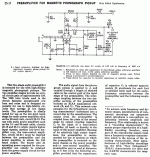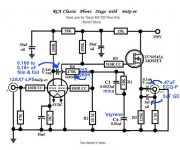A month or so ago I helped a friend move. Among the things he didn't want to hang on to was a Sony PS-LX5 turntable, an Optimus SA-155 integrated stereo amp, and a pair of Sony SS-B1000 bookshelf speakers. Seeings as I had a couple banker boxes full of records I had been dragging around for years but with no way to listen to them, I used my car as the dumpster for these 3 items.
Hooray, I can now listen to my record collection again.
While it's nice to be able to listen to my favorite songs again, it doesn't have the same punch it use to. I know it's due to the low end equipment. Due to budget constraints I can't go out and buy a high end hi-fi stereo system, so I have decided to build one... and buy it one piece at a time.
I am budgeting a year's worth of time and between $100 and $200 a month to build it.
As a Ham, I have some background with electronics and vacuum tubes. I have 3 vacuum tube based transceivers and a Drake transmitter and receiver combo that I bough as "for part" and repaired. They all currently function well within spec. I've also built several Nixie tube clocks, mostly from kits. As a result, I have a decent supply of spare parts, some NOS, some salvage, and some brand new.
This will be my first "from scratch" project.
I have been struggling with where to start. I've spent the better part of the month searching the web and poking around in several forums. I've learned a lot, certainly not everything, in that time. Things like RIAA Equalization, Toroidal vs. EI transformers, and amp vs pre-amp, come to mind as new concepts, for me. My second decision was to find a source for advice.
I've decided to make diyAudio my home for advice.
My first decision was to settle on a design. I have come to love steampunk over the years, and vacuum tubes seem to cater to that aesthetic. I will be trying to generate an end product that feels steampunk. Advisable or not, I have also decided that this will be a project exclusively for a Turntable. I believe my digital music can use digital equipment. The most important design constraint I struggled with was the electronic design. I've settled, for this first project, on a Marantz model 7 based design for my pre-amp. Followed closely, if I can get them to marry up, by an Amity power amp built monoblock style. Later, I'll have to upgrade, or build, my speakers and finally improve the turntable.
The next step is to build a BOM and start sourcing parts.
This is the Marantz Model 7 schematic from their service manual.

I want to start by building the power supply. In order to truly introduce you to my handicap I drew up a rough sketch of the power supply section as I would like to create it but component specs are pretty much beyond me at this early stage.

If anybody would care to spec these components or tell me where I've gone wrong I would greatly appreciate the help, especially if I can/should be using CLC instead of CRC filter networks and/or AC would be better for filament heating. The first components I'd like to buy will be the Power Transformer and the 2 Rectifier tubes. However I may have some tubes at the house. I'll look as soon as I get home. I also have a couple voltage regulator tubes but those are of the 0C3 variety and probably won't be of any help here.
Thanks in advance for your help and best regards,
Dale
Hooray, I can now listen to my record collection again.
While it's nice to be able to listen to my favorite songs again, it doesn't have the same punch it use to. I know it's due to the low end equipment. Due to budget constraints I can't go out and buy a high end hi-fi stereo system, so I have decided to build one... and buy it one piece at a time.
I am budgeting a year's worth of time and between $100 and $200 a month to build it.
As a Ham, I have some background with electronics and vacuum tubes. I have 3 vacuum tube based transceivers and a Drake transmitter and receiver combo that I bough as "for part" and repaired. They all currently function well within spec. I've also built several Nixie tube clocks, mostly from kits. As a result, I have a decent supply of spare parts, some NOS, some salvage, and some brand new.
This will be my first "from scratch" project.
I have been struggling with where to start. I've spent the better part of the month searching the web and poking around in several forums. I've learned a lot, certainly not everything, in that time. Things like RIAA Equalization, Toroidal vs. EI transformers, and amp vs pre-amp, come to mind as new concepts, for me. My second decision was to find a source for advice.
I've decided to make diyAudio my home for advice.
My first decision was to settle on a design. I have come to love steampunk over the years, and vacuum tubes seem to cater to that aesthetic. I will be trying to generate an end product that feels steampunk. Advisable or not, I have also decided that this will be a project exclusively for a Turntable. I believe my digital music can use digital equipment. The most important design constraint I struggled with was the electronic design. I've settled, for this first project, on a Marantz model 7 based design for my pre-amp. Followed closely, if I can get them to marry up, by an Amity power amp built monoblock style. Later, I'll have to upgrade, or build, my speakers and finally improve the turntable.
The next step is to build a BOM and start sourcing parts.
This is the Marantz Model 7 schematic from their service manual.

I want to start by building the power supply. In order to truly introduce you to my handicap I drew up a rough sketch of the power supply section as I would like to create it but component specs are pretty much beyond me at this early stage.

If anybody would care to spec these components or tell me where I've gone wrong I would greatly appreciate the help, especially if I can/should be using CLC instead of CRC filter networks and/or AC would be better for filament heating. The first components I'd like to buy will be the Power Transformer and the 2 Rectifier tubes. However I may have some tubes at the house. I'll look as soon as I get home. I also have a couple voltage regulator tubes but those are of the 0C3 variety and probably won't be of any help here.
Thanks in advance for your help and best regards,
Dale
Well, I think the marantz 7 and similar products fom MacIntosh, are ambitios and overly complex. Tone controls? How 1970's! But hey, with your Ham background, (I used to be WN7TTS), wecome to the club, enjoy the quest! As Eli may point out, a great place to start with a phono stage is the vererable RCA stage from the back of the tube manual. Best of luck!!
Well, I think the marantz 7 and similar products fom MacIntosh, are ambitios and overly complex. Tone controls? How 1970's! But hey, with your Ham background, (I used to be WN7TTS), wecome to the club, enjoy the quest! As Eli may point out, a great place to start with a phono stage is the vererable RCA stage from the back of the tube manual. Best of luck!!
If modified, the RCA setup gets the job done. I've uploaded both the original and the tweaked version. The tweaks dispose of 2 weaknesses in the original: wretched drive capability and mediocre bass extension. A few MM carts. and step up trafos (SUTs) interact badly with 'X7 Miller capacitance, but most are just fine.
Contact member Jeff Yourison for his build experience and a nice schematic of a low cost/good performing PSU.
That 1st $200 might get the phono section done.
BTW, Mr. Brown's lack of regard for tone controls is not misplaced. Very few recordings benefit from their presence. "Correct" implementation of tone controls is NOT simple. For starters, they need to be completely removable from the signal path.
Attachments
without specs, its a little hard to be specific, but the power supply as drawn looks to be an very high impedance affair.
Tube rectification may look nice, but its an expensive way to get to an outcome - smooth stable DC. Sand is a much more effective way to spend and leaves more for the other bits. In fact, going to silicon diodes would almost cover the cost of an L component in the smoothing network - a much better spend imo.
Alternatively, use the extra DC voltage availablefrom using sand to supply a good ripple removing regulator. Immediate improvements in power supply impedance, DC smoothing and supply regulation.
Tube rectification may look nice, but its an expensive way to get to an outcome - smooth stable DC. Sand is a much more effective way to spend and leaves more for the other bits. In fact, going to silicon diodes would almost cover the cost of an L component in the smoothing network - a much better spend imo.
Alternatively, use the extra DC voltage availablefrom using sand to supply a good ripple removing regulator. Immediate improvements in power supply impedance, DC smoothing and supply regulation.
Thank you for your replies. I can lose the tone controls without much thought, except, what am I going to be left with. I suppose I'll retain the path as indicated by the switch positions in the schematic above. I do want to keep the different eq filters and be able to switch between them, if for no other reason that to impress my granddad when I can play one of his old records on it. My hope was for a silicon-less system. I'm somewhat confident that the RECT 1 and RECT 2 in the original was a copper oxide or selenium type rectifier which would look cool atop a steampunk amp but they don't appear to have been all that reliable, especially the selenium variety. I can probably be convinced to use diodes but I'd like to investigate other avenues first. I have seen some amp schematics using AC for filament supply. I believe those were mostly of the 6 volt variety and mostly in power amps but would it be possible to use AC here?
I'd planned to build and test this pre-amp in 3 phases. The first being the Power Supply because with out it nothing else can be tested. The second would be the EQ filtering section. And lastly, the output stage which is now kind of up in the air. All I really know about the output stage at this point is that I want it to match as best it can to the input stage of my next project which will be the Amity amp designed by Linn Olson.
I'd planned to build and test this pre-amp in 3 phases. The first being the Power Supply because with out it nothing else can be tested. The second would be the EQ filtering section. And lastly, the output stage which is now kind of up in the air. All I really know about the output stage at this point is that I want it to match as best it can to the input stage of my next project which will be the Amity amp designed by Linn Olson.
Unfortunately, the marantz 7 service manual calls out 12AX7's as all the tubes in this pre-amp so, who knows, maybe they arn't destined to be married.The preamp has to drive the combined capacitance of the interconnect cable, the input transformer, and the Miller capacitance of the input tubes. This can easily add up to 200 to 600pF of capacitance, depending on how long your cables are and if you choose to use a 1:2 step-up in the input transformer (which quadruples the 60pF Miller capacitance of the input tubes). In all honesty, this is difficult load for most tube preamps, with 12AX7 cathode-follower preamps falling down the worst. (1mA cannot drive 600pF!) Preamps with 12AU7 cathode-followers aren't much better, sounding very "tubey," rolled-off, and old-fashioned.
I would look at more modern designs found here and elsewhere. My very first attempt at a scratch built tube pre-amp almost 30yrs ago was an ARC SP-3 inspired design without tone controls. While it worked I was terribly disappointed with the overall performance and ended up starting to design my own stuff, and in the end found I was relatively good at it, never looked back.
I'd have a look at Salas' 6V6 line stage and his Valve Itch Phono:
http://www.diyaudio.com/forums/tubes-valves/102352-6v6-line-preamp.html
http://www.diyaudio.com/forums/analogue-source/140635-valve-itch-phono.html
There are lots of other phonostage designs in analogue source including some of mine like the Muscovite series - none of mine IMHO are newbie friendly.
The Salas stuff is really well thought out, will run circles around the Marantz in terms of performance and are much simpler. Many people have built these designs with great success and pleasure with the results achieved.
The early ARC stuff is very similar topologically speaking to the Marantz 7, and several of the McIntosh C series pre-amps, none IMHO represent anything close to what can be achieved with tubes these days.
I'd have a look at Salas' 6V6 line stage and his Valve Itch Phono:
http://www.diyaudio.com/forums/tubes-valves/102352-6v6-line-preamp.html
http://www.diyaudio.com/forums/analogue-source/140635-valve-itch-phono.html
There are lots of other phonostage designs in analogue source including some of mine like the Muscovite series - none of mine IMHO are newbie friendly.
The Salas stuff is really well thought out, will run circles around the Marantz in terms of performance and are much simpler. Many people have built these designs with great success and pleasure with the results achieved.
The early ARC stuff is very similar topologically speaking to the Marantz 7, and several of the McIntosh C series pre-amps, none IMHO represent anything close to what can be achieved with tubes these days.
Well, I've taken a step back and decided I need to have a solid and complete design that "should" work. I've never designed a circuit and have realized there is a lot I need to learn. It's tricky though because I want to get started. I've got a long road ahead of me.
In an effort to accelerate my learning curve I've downloaded LTSpice and have been learning how to use it. I have gotten as far as building a "functional" circuit with tube models, but I don't know what I'm doing where the Voltage source's are concerned nor do I understand the data the curves represent. If anybody's interested I can post what I've got.
The other and, at least in my mind, most important lesson I need to learn is what the tubes. I get how they work on a fundamental level but there are a lot of numbers and graphs to look at that I haven't even remotely begun to understand.
Does it make me crazy that a little thing like wanting a volume control can take me down these dark windy roads? All I really want out of this first project is a volume control, fairly accurate RIAA equalization, and enough oomph to push a power amp. The last 2 seem pretty easy to find proven designs for.
In an effort to accelerate my learning curve I've downloaded LTSpice and have been learning how to use it. I have gotten as far as building a "functional" circuit with tube models, but I don't know what I'm doing where the Voltage source's are concerned nor do I understand the data the curves represent. If anybody's interested I can post what I've got.
The other and, at least in my mind, most important lesson I need to learn is what the tubes. I get how they work on a fundamental level but there are a lot of numbers and graphs to look at that I haven't even remotely begun to understand.
Does it make me crazy that a little thing like wanting a volume control can take me down these dark windy roads? All I really want out of this first project is a volume control, fairly accurate RIAA equalization, and enough oomph to push a power amp. The last 2 seem pretty easy to find proven designs for.
i did this for a first preamp project.....
broskie ccda.....CCDA: constant-current-draw amplifier
broskie ccda.....CCDA: constant-current-draw amplifier
- Status
- This old topic is closed. If you want to reopen this topic, contact a moderator using the "Report Post" button.
- Home
- Amplifiers
- Tubes / Valves
- And so it begins...

